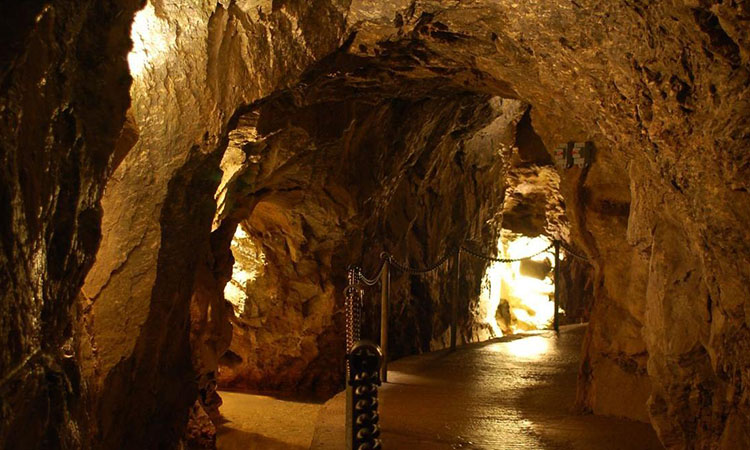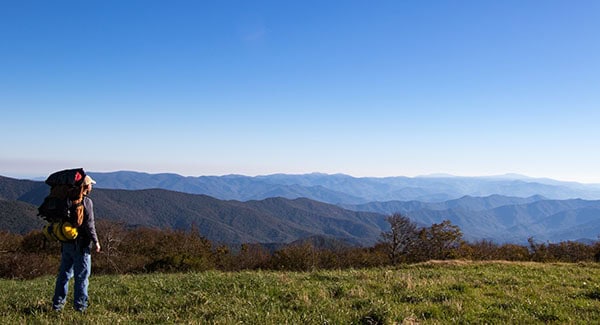Last Updated on March 23, 2023
Mountain peaks attract a lot of attention in Western North Carolina. From the rolling foothills of Polk County to the tip of Mt. Mitchell at 6,684 feet, there are a lot of places to enjoy wonderful vistas and life among the clouds.
But our prehistoric Blue Ridge Mountains offer more wonders, if only we would stop and look down for a minute. No, look really down.
Here are seven fun facts you never knew about Linville Caverns, located just outside Linville Falls, NC.
1. This year marks the 200th anniversary of the discovery of Linville Caverns
It took millions of years for these limestone caverns to form in a deposit of Shady Dolomite at the base of Humpback Mountain. And it took nearly as long for humans to discover them. There are stories of Native Americans exploring these wonders throughout the centuries. But in 1822, a Fayetteville naturalist got the credit for discovering them. The story goes, a fishing expedition headed by Henry E. Colton was “astounded to see fish swimming in and out of what appeared to be rather solid rock.” They followed the fish to a small opening that led them to the cave formation that is still home to an underground stream with native trout.
The caverns have been called many names throughout the years, including Humpback Cave, McGhee Cave, Gilkey Caverns, The Cave beneath Sunnalee, and Catawba Cave.
2. Linvillle is North Carolina’s only show cave
Geologists know of 900 natural caves in North Carolina. But Linville Caverns is the only one open to the public. A group of businessmen bought the land in 1937, led by J.G. Gilkey of Marion and Wade Phillips of Lexington. According to the N.C. Government & Heritage Library, “The project coincided with construction of the Blue Ridge Parkway in McDowell and Avery Counties in 1938.” Once the caverns opened to the public on July 1, 1939, the attraction became an overnight success, with newspapers reporting thousands of visitors. Today, the privately-owned caverns continue to draw nearly 100,000 visitors each year.
3. But humans aren’t the only ones visiting the caverns
As we mentioned above, the first visitors to the cave were probably the rainbow and brook trout who swim the stream year round. These trout have evolved to be blind because of the perpetually pitch-black environment. Local spiders and mice have also found their way into the caves.
Perhaps the most famous residents are the Eastern pipistrelle (tricolored) and little brown bats. These insect-eating creatures hibernate in the caverns from late fall until early spring. However, the bats’ population has been recently decimated by White-nose syndrome, a disease caused by the fungus Pseudogymnoascus destructans. The fungus is harmless to humans and domestic animals. But it is deadly to bats because it disturbs their hibernation cycle, and thus their ability to retain calories throughout the winter months. The Linville Caverns visitor center takes steps to mitigate the spread of the fungus by asking guests to step in a bleach solution that kills any fungus on the soles of their shoes.
4. Linville Caverns are deep, and only half the length is accessible
When we say these caverns are at the base of Humpback Mountain, we mean it. In fact, they’re a full 2,500 feet below the pinnacle of this peak. Cave explorers over the past two centuries have discovered that the caves reach 1,300 feet into the subterranean environment. However, your guided tour will cover only about 600 feet from the entrance. The deepest 700 feet is too narrow and dangerous for regular traffic.
While you may not notice much of a change from year to year, Linville Caverns remain actively growing. Water from the mountain continues to seep through cracks in the rocks to mold and shape the “colorful speleothem” visible to visitors. Among the interesting formations are stalactites and stalagmites, flowstones, and a “bottomless pool” that reaches a depth of more than 250 feet. Some formations are said to look like bowling pins, a wedding party, a polar bear, and a mother-in-law.
5. They’re also better climate controlled than your house
One reason animals (and tourists!) are drawn to the recesses of Linville Caverns is for a respite from the weather outside. The interior of the caverns are insulated from the weather by tons of rock from Humpback Mountain, meaning their 52-degree-Fahrenheit temperature stays nearly constant year round. On chilly winter days like today, that means bats stay warm during their winter hibernation. And on sweltering summer afternoons, trout prefer the cool waters that flow through the cave.
6. And they have something in common with the Titanic
There are only two places on Earth where people can experience total darkness. More than 2,000 meters (6,600 feet) below sea level, sunlight can no longer penetrate the water of the ocean’s abyssal zone, and this region remains in perpetual darkness. The Titanic sits on the ocean floor at twice that depth, around 13,000 feet.
The only other place where you can experience total and complete darkness is deep inside a cave, such as Linville Caverns. (It’s much easier to get to, too.) According to Linville Caverns tour guides, humans go completely blind from total darkness in 3–6 months—but you go crazy first, hearing imaginary voices within just a few minutes. Don’t believe us? Take the tour!
7. Federal laws protect Linville Caverns
In 1987, the North Carolina General Assembly passed the Cave Protection Act. This act provided for “the conservation of the unique geologic formations inside the state’s caves by making damage and removal of features unlawful.” It is a federal offense, punishable by law, to harm or destroy any part of a cavern system.
In 1988, the state registered the caverns as a Natural Heritage Area, which regulates what the caverns’ private owners can do with it. It also makes it illegal for visitors to pick the delicate, vibrant wildflowers on the rock face outside the entrance. Resist the urge.
How to find Linville Caverns
After nearly 100 years, Linville Caverns continues to operate as a private enterprise. The caverns are open for 30–40-minute guided tours, with some wheelchair accessibility, which begin regularly several times an hour. Visitors learn about the geology of the formations and hear lore about the caverns, including the tale of Civil War deserters who used the caverns as a hideout.
The entrance to the cave, visitor center, and gift shop are located off U.S. Route 221 in McDowell County, a few miles south of Linville Falls and four miles from the Blue Ridge Parkway.
19929 US 221 North, Marion | (828) 756-4171 | linvillecaverns.com
About McDowell County
Native American tribes first settled in this region more than 6,000 years ago. And in the early 1700s, the fertile Catawba River basin attracted Ulster Scots and German settlers. McDowell County was the western outpost of European settlement in America until the Revolutionary War. Today, the county’s 46,000 residents live in and around the towns of Lake James, Linville Falls, Little Switzerland, Marion, and Old Fort.
Elevations here top 4,000 feet above sea level, opening up to views of the green valley floors below. McDowell County lands include 67,000 acres of Pisgah National Forest, the Overmountain Victory National Historic Trail, the Blue Ridge Parkway (which forms 30 miles of the county’s northern border), Catawba Falls, and the Linville Gorge Wilderness Area. The 220-mile-long Catawba River, named after the Native American tribes that first settled on the banks, flows east to west, dividing the county.
Does that sound like the perfect lifestyle for you? Find your dream home in McDowell County now!




